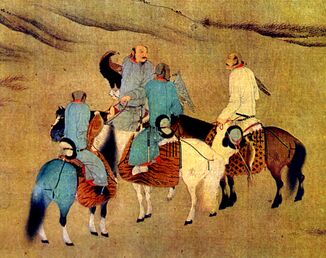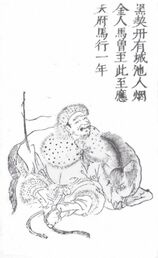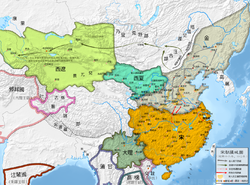قرة خيتاي
| ||||||||||||||||||||||||||||||||||||||||||||||||||||||||||||||||||
قرة خيطاي (Qara Khitai ؛ alternatively spelled Kara Khitai, بالمنغولية: Хар Хятан, 1124[أ]–1218), also known as the خانية قرة خيطان أو لياو الغربية (الصينية التقليدية: 西遼؛ الصينية المبسطة: 西辽؛ پنين: Xī Liáo�)، ورسمياً هي لياو الكبرى (الصينية التقليدية: 大遼؛ الصينية المبسطة: 大辽؛ پنين: Dà Liáo�)، كانت امبراطورية الخيطان المصيـّنة في آسيا الوسطى. الأسرة أسسها يلو داشي، الذي قاد بقايا أسرة لياو إلى آسيا الوسطى بعد الفرار من Jurchen conquest of their homeland in the north and northeast of modern-day China. The empire was usurped by the Naimans under Kuchlug in 1211; traditional Chinese, Persian, and Arab sources considered the usurpation to be the end of the Qara Khitai rule.[5] الامبراطورية فتحتها لاحقاً الامبراطورية المنغولية في 1218.
. . . . . . . . . . . . . . . . . . . . . . . . . . . . . . . . . . . . . . . . . . . . . . . . . . . . . . . . . . . . . . . . . . . . . . . . . . . . . . . . . . . . . . . . . . . . . . . . . . . . . . . . . . . . . . . . . . . . . . . . . . . . . . . . . . . . . . . . . . . . . . . . . . . . . . . . . . . . . . . . . . . . . . . .
الأسماء
The Qara Khitai took on trappings of a Chinese state and inherited the dynastic name "Great Liao".[6][7][8] Hence, Chinese, Korean, Japanese and Vietnamese historians generally refer to the empire as the "Western Liao", emphasizing its continuation from the Liao dynasty.
The name "Qara Khitai", commonly used by Central Asian tribes to refer to the dynasty, is also commonly used in Western scholarly works. The term is often translated as the Black Khitans in Mongolian, but its original meaning is unclear today.[9] In Modern Mongolian, "Kara-Khitan" is rendered "Хар Хятан" (Khar Khyatan). Since no direct records from the empire survive today, the only surviving historical records about the empire come from foreign sources.
"Black Khitans" (黑契丹) has also been seen used in Chinese. "Qara," which literally means "black," corresponds with the Liao's dynastic color black and its dynastic element water, according to the theory of five elements (wuxing).[10] The Jurchens referred to the empire as "Dashi" or "Dashi Linya" (after its founder), to reduce any claims the empire may have had to the old territories of the Liao dynasty. Muslim historians initially referred to the state simply as "Khitay" or "Khitai;" they may have adopted this form of "Khitan" via the Uyghurs of Kocho in whose language the final -n or -ń became -y.[11] Only after the Mongol conquest did the state begin to be referred to in the Muslim world as the "Kara-Khitai" or "Qara-Khitai."[12] Khitan is the origin of "Cathay", a foreign name for China.
التاريخ
تأسيس قرة خيطاي
The Qara Khitai empire was established by Yelü Dashi, who led nomadic Khitans west by way of Mongolia after the collapse of the Liao dynasty. The Jurchens, once vassals of the Khitans, had allied with the Song dynasty and overthrown the Liao. Yelü recruited Khitans and other tribes to form an army, and in 1134 captured Balasagun from the Kara-Khanid Khanate, which marks the start of the empire in Central Asia. The Khitan forces were soon joined by 10,000 Khitans, who had been subjects of the Kara-Khanid Khanate. The Khitans then conquered Kashgar, Khotan, and Beshbalik. The Khitans defeated the Western Kara-Khanid Khanate at Khujand in 1137, eventually leading to their control over the Fergana Valley. They won the Battle of Qatwan against the Western Kara-Khanids and the Seljuk Empire on September 9, 1141, which allowed the Khitans to gain control over Transoxiana.[13]
خلفاء يلو داشي
توفي يلو داشي في 1143, and his wife, Xiao Tabuyan, then acted as regent for their son. Their son, Yelü Yiliu, became the ruler in 1150 and died in 1163, to be succeeded by his sister, Yelü Pusuwan. She sent her husband, Xiao Duolubu, on many military campaigns. She then fell in love with his younger brother, Xiao Fuguzhi. They were executed in 1177 by her father-in-law, Xiao Wolila, who then placed Yelü Zhilugu on the throne in 1178. The empire was weakened by rebellions and internal wars among its vassals, especially during the latter parts of its history.
Kuchlug's usurpation and end of the Khanate
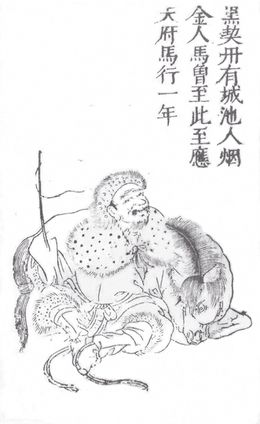
In 1208, a Naiman prince, Kuchlug, fled his homeland after being defeated by Mongols. Kuchlug was welcomed into the empire of the Qara-Khitans, and was allowed to marry Zhilugu's daughter. However, in 1211, Kuchlug revolted, and later captured Yelü Zhilugu while the latter was hunting. Zhilugu was allowed to remain as the nominal ruler but died two years later, and many historians regarded his death as the end of the Qara-Khitan empire. In 1216, Genghis Khan dispatched his general Jebe to pursue Kuchlug; Kuchlug fled, but in 1218, he was finally captured and decapitated. The Mongols fully conquered the former territories of the Qara-Khitans in 1220.
الأعقاب
The Qara Khitais became absorbed into the Mongol Empire; a segment of the Qara-Khitan troops had previously already joined the Mongol army fighting against Kuchlug. Another segment of the Qara-Khitans, in a dynasty founded by Buraq Hajib, survived in Kirman as a vassal of the Mongols, but ceased to exist as an entity during the reign of Öljaitü of the Ilkhanate.[14] The Qara-Khitans were dispersed widely all over Eurasia as part of the Mongol army. In the 14th century, they began to lose their ethnic identity, traces of their presence however may be found as clan names or toponyms from Afghanistan to Moldova. Today a Khitay tribe still lives in northern Kyrgyzstan.[11]
الادارة
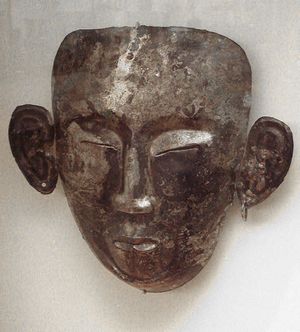
The Khitans ruled from their capital at Balasagun (in today's Kyrgyzstan), directly controlling the central region of the empire. The rest of their empire consisted of highly autonomous vassalized states, primarily Khwarezm, the Karluks, the Kingdom of Qocho of the Uyghurs, the Kankali, and the Western, Eastern, and Fergana Kara-Khanids. The late-arriving Naimans also became vassals, before usurping the empire under Kuchlug.
The Khitan rulers adopted many administrative elements from the Liao dynasty, including the use of Confucian administration and imperial trappings. The empire also adopted the title of Gurkhan (universal Khan). The Khitans used the Chinese calendar, maintained Chinese imperial and administrative titles, gave its emperors reign names, used Chinese-styled coins, and sent imperial seals to its vassals.[15] Although most of its administrative titles were derived from Chinese, the empire also adopted local administrative titles, such as tayangyu (Turkic) and vizier.
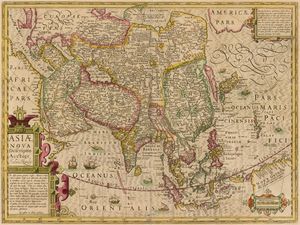
The Khitans maintained their old customs, even in Central Asia. They remained nomads, adhered to their traditional dress, and maintained the religious practices followed by the Liao dynasty Khitans. The ruling elite tried to maintain the traditional marriages between the Yelü king clan and the Xiao queen clan, and were highly reluctant to allow their princesses to marry outsiders. The Qara-Khitai Khitans followed a mix of Buddhism and traditional Khitan religion, which included fire worship and tribal customs, such as the tradition of sacrificing a gray ox with a white horse. In an innovation unique to the Qara-Khitai, the Khitans paid their soldiers a salary.
The empire ruled over a diverse population that was quite different from its rulers. The majority of the population was sedentary, although the population suddenly became more nomadic during the end of the empire, due to the influx of Naimans. The majority of their subjects were Muslims, although a significant minority practiced Buddhism and Nestorianism. Although Chinese and Khitan were the primary languages of administration, the empire also administered in Persian and Uyghur.[3]
الارتباط بالصين
جزء من سلسلة عن |
|---|
| تاريخ شينجيانگ |
 |
After the Tang dynasty, non-Han Chinese empires gained prestige by connecting themselves with China, and the Khitan Gurkans used the title of Chinese emperor,[16][17] and was also called the Khan of Chīn.[18] The Qara Khitai used the "image of China" to legitimize their ruler to the Central Asian Muslims. The Chinese emperor, together with the rulers of the Turks, Arabs, India and Byzantium, were known to Islamic writers as the world's "five great kings".[19] The Khitan Qara-Khitai empire in Central Asia kept the trappings of a Chinese state, such as Chinese coins, the Chinese writing system, tablets, seals, and used Chinese products like porcelein, mirrors, jade and other Chinese customs. The adherence to Liao Chinese traditions has been suggested as a reason why the Qara Khitai did not convert to Islam.[20] Despite the Chinese trappings, there were comparatively few Han Chinese among the population of the Qara Khitan.[21] These Han Chinese had lived in Kedun during the Liao dynasty,[22] and in 1124 migrated with the Khitans under Yelü Dashi along with other people of Kedun, such as Bohai, Jurchen, Mongol tribes, Khitan, in addition to the Xiao consort clan.[23]
Qara Khitai's rule over Muslim Central Asia has the effect of reinforcing the view among some Muslim writers that Central Asia was linked to China a few hundred years after the Tang dynasty had lost control of the region. Marwazī wrote that Transoxania was a former part of China,[24] while Fakhr al-Dīn Mubārak Shāh defined China as part of "Turkestan", and the cities of Balāsāghūn and Kashghar were considered part of China.[25]
. . . . . . . . . . . . . . . . . . . . . . . . . . . . . . . . . . . . . . . . . . . . . . . . . . . . . . . . . . . . . . . . . . . . . . . . . . . . . . . . . . . . . . . . . . . . . . . . . . . . . . . . . . . . . . . . . . . . . . . . . . . . . . . . . . . . . . . . . . . . . . . . . . . . . . . . . . . . . . . . . . . . . . . .
الذكرى
The association of Khitai with China meant that the most enduring trace of the Khitan's power is names that are derived from it, such as Cathay, which is the medieval Latin appellation for China. Names derived from Khitai are still current in modern usage, such as the Russian, Bulgarian, Uzbek and Mongolian names for China.[11] However, the use of the name Khitai to mean "China" or "Chinese" by Turkic speakers within China, such as the Uyghurs, is considered pejorative by the Chinese authorities, who tried to ban it.[26]
حكام قرة خيطاي
| اسم المعبد (廟號 miàohào) | Posthumous Names (諡號 shìhào) | اسم الميلاد | Convention[بحاجة لمصدر] | فترة الحكم | Era Names (年號 niánhào) and their according range of years |
|---|---|---|---|---|---|
| 1. Dezong (德宗 Dézōng) | Emperor Tianyou Wulie (天祐武烈帝 Tiānyòu Wǔliè Dì) | Yelü Dashi (耶律大石 Yēlǜ Dàshí or 耶律達實 Yēlǜ Dáshí) 1 | use birth name | 1124–1144 | Yanqing (延慶 Yánqìng) 1124 or 1125–1134 Kangguo (康國 Kāngguó) 1134–1144 |
| Not applicable | Empress Gantian (感天皇后 Gǎntiān Huánghòu) (regent) | Xiao Tabuyan (蕭塔不煙 Xiāo Tǎbùyān) | "Western Liao" + posthumous name | 1144–1150 | Xianqing (咸清 Xiánqīng) 1144–1150 |
| 2. Emperor Renzong (仁宗 Rénzōng) | Too tedious thus not used when referring to this sovereign | Yelü Yilie (耶律夷列 Yēlǜ Yíliè) | "Western Liao" + temple name | 1150–1164 | Shaoxing (紹興 Shàoxīng) or Xuxing (Xùxīng 續興)2 1150–1164 |
| Not applicable | Empress Dowager Chengtian (承天太后 Chéngtiān Tàihòu) (regent) | Yelü Pusuwan (耶律普速完 Yēlǜ Pǔsùwán) | "Western Liao" + posthumous name | 1164–1178 | Chongfu (崇福 Chóngfú) 1164–1178 |
| 3. Did not exist | Mozhu (末主 Mòzhǔ "Last Lord") or Modi (末帝 Mòdì "Last Emperor") | Yelü Zhilugu (耶律直魯古 Yēlǜ Zhílǔgǔ) | use birth name | 1178–1211 | Tianxi (天禧 Tiānxī) 1178–1218 |
| Did not exist | Did not exist | Kuchlug (Ch. 屈出律 Qūchūlǜ) | use birth name | 1211–1218 | |
| 1 "Dashi" might be the Chinese title "Taishi", meaning "vizier"; or, it could mean "Stone" in Turkish, as the Chinese transliteration suggests. 2 Recently discovered Western Liao coins have the era name "Xuxing", suggesting that the era name "Shaoxing" recorded in Chinese sources may be incorrect.[27] | |||||
انظر أيضاً
ملاحظات
- ^ 1124 is the year in which Yelü Dashi proclaimed himself king, while still in Mongolia.
المراجع
الهامش
- ^ Rene Grousset, The Empire of the Steppes: A History of Central Asia, (Rutgers University Press, 1991), 165.
- ^ Janhunen 2006, p. 114.
- ^ أ ب Biran 2005, p. 94.
- ^ أ ب Rene Grousset, 165.
- ^ Biran 2005, p. 2.
- ^ خطأ استشهاد: وسم
<ref>غير صحيح؛ لا نص تم توفيره للمراجع المسماةGreatLiao - ^ Morgan & Stewart 2017, pp. 56–57.
- ^ Schouenborg, Laust (2016). International Institutions in World History: Divorcing International Relations Theory from the State and Stage Models. Taylor & Francis. p. 133. ISBN 9781315409887.
- ^ Biran 2005, pp. 216–217.
- ^ Chen, Yuan Julian (2014). "Legitimation Discourse and the Theory of the Five Elements in Imperial China". Journal of Song-Yuan Studies (in الإنجليزية). 44 (44): 325–364. doi:10.1353/sys.2014.0000. S2CID 147099574.
- ^ أ ب ت Sinor, D. (1998), "Chapter 11 - The Kitan and the Kara Kitay", in Asimov, M.S.; Bosworth, C.E., History of Civilisations of Central Asia, 4 part I, UNESCO Publishing, ISBN 92-3-103467-7
- ^ Biran 2005, pp. 215–217.
- ^ Grousset, Rene, The Empire of the Steppes: A History of Central Asia , (Rutgers University Press, 2002), 165.
- ^ Biran 2005, p. 87.
- ^ Biran 2005, p. 93-131.
- ^ James A. Millward (2007). Eurasian Crossroads: A History of Xinjiang. Columbia University Press. pp. 42–. ISBN 978-0-231-13924-3.
- ^ Biran, Michal (2001). ""Like a Might Wall:" The armies of the Qara Khitai" (PDF). Jerusalem Studies in Arabic and Islam. 25: 46.
- ^ Biran 2005, p. 34.
- ^ Biran 2005, p. 97.
- ^ Biran 2005, p. 102, 196–201.
- ^ Biran 2005, p. 96–.
- ^ Biran 2005, p. 27–.
- ^ Biran 2005, p. 146.
- ^ Biran 2005, p. 98–99.
- ^ Biran 2005, p. 99–101.
- ^ S.F.Starr, ed. (2004). Xinjiang: China's Muslim Boarderland. M.E. Sharpe. p. 43. ISBN 9781317451372.
{{cite book}}: Cite uses deprecated parameter|authors=(help) - ^ Belyaev, V.A.; Nastich, V.N.; Sidorovich, S.V. (2012). "The coinage of Qara Khitay: a new evidence (on the reign title of the Western Liao Emperor Yelü Yilie)". Proceedings of the 3rd Simone Assemani Symposium, September 23–24, 2011, Rome.
المصادر
- Biran, Michal (2005). The Empire of the Qara Khitai in Eurasian History: Between China and the Islamic World. Cambridge Studies in Islamic Civilization. Cambridge, England: Cambridge University Press. ISBN 0521842263.
{{cite book}}: Invalid|ref=harv(help) - Pozzi, Alessandra; Janhunen, Juha Antero; Weiers, Michael, eds. (2006). Tumen Jalafun Jecen Aku: Manchu Studies in Honour of Giovanni Stary. Otto Harrassowitz Verlag. ISBN 978-3-447-05378-5.
{{cite book}}: Invalid|ref=harv(help)
- CS1 errors: deprecated parameters
- Pages using infobox country with unknown parameters
- Articles containing منغولية-language text
- مقالات تحتوي نصوصاً باللغة الصينية التقليدية
- مقالات تحتوي نصوصاً باللغة الصينية المبسطة
- Articles with hatnote templates targeting a nonexistent page
- Pages using multiple image with auto scaled images
- Articles with unsourced statements from April 2012
- Pages with empty portal template
- Khitan history
- أسرة لياو
- خانيات
- الشعوب القديمة في الصين
- تاريخ آسيا الوسطى
- تاريخ قزخستان
- تاريخ منغوليا
- القرن 12 في آسيا
- القرن 13 في آسيا
- القرن 12 في الصين
- القرن 13 في الصين
- تأسيسات عقد 1120 في آسيا
- انحلالات 1218 في آسيا
- دول وأراضي تأسست في 1124
- دول وأراضي انحلت في 1218
- Persian-speaking countries and territories

